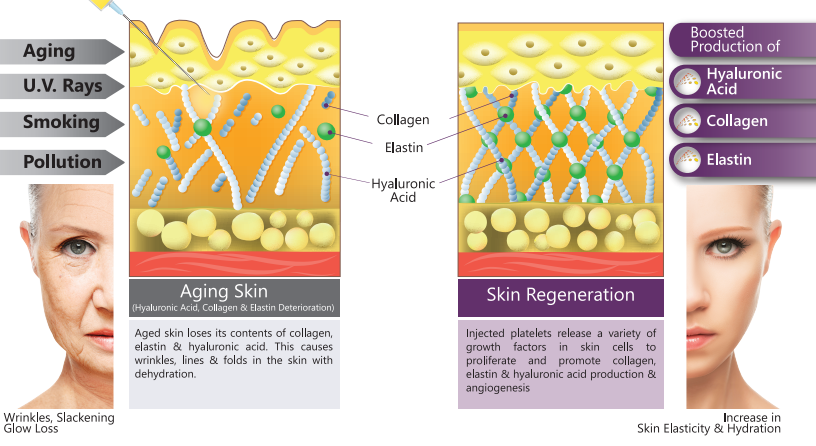Normal healthy skin has a nice epidermis with a smooth cornified, or outer, the layer that operates as a good barrier to water and environmental injury. Skin color and tone are even and unblemished. Components such as collagen (which provides skin firmness) elastin (which supplies skin elasticity and rebound), and glycosaminoglycans or GAGs (which keep the skin hydrated) are all abundant. It is interesting to note that under a microscope, a biopsy of a wrinkle reveals no telltale signs indicating it is a wrinkle. So what causes the skin to look wrinkled? It is probably a multi-factorial process of intrinsic and extrinsic aging.
Intrinsic aging is the natural aging process that takes place over the years regardless of outside influences. After the age of 20, a person produces about 1 percent less collagen in the skin each year. As a result, the skin becomes thinner and more fragile with age. There is also a diminished functioning of the sweat and oil glands, less elastin production and less GAG formation. Wrinkle formation as a result of intrinsic aging is inevitable, but it will always be slight. Age-dependent modification of the facial Subcutaneous White Adipose Tissue (SWAT), connected with reduction of its volume and modification of collagen content, adhesion between dermal and adipose layers, can significantly influence mechanical stability of the skin and cause the development of aging symptoms such as wrinkle. Bone resorption is effective in creating skin folds.
age-related bone loss is the consequence of two simultaneous but opposing processes: subperiosteal apposition, which takes place on the outside of the bone and endosteal bone resorption, which takes place on the inside of the bone. With increasing age, bone remodeling is reduced and this leads to a negative bone balance at individual BMU sites. After the fourth decade of life, there is a reduction in the formation of periosteal bone and at the same time there is an increasing number of remodeling units within endosteal bone resulting in a linear increase in endosteal bone resorption in both sexes.
Extrinsic aging occurs in addition to intrinsic aging as a result of sun and environmental damage (smoking and uv, for example).
Sun damage
Excessive exposure to ultraviolet (UV) radiation of the sun can result in premature aging of the skin, which is also known as photoaging. Exposure to UV light breaks down collagen fibers and leads to the production of abnormal elastin. When ultraviolet light damages skin tissue, an enzyme, called metalloproteinase, is produced. This enzyme creates and reforms collagen. During the process, however, some healthy collagen fibers are damaged, resulting in solar elastosis—the disorganized formation of fibers. Wrinkles develop when the rebuilding process occurs over and over, less efficiently each time.
Smoking
Researchers have found that smoking causes a marked reduction in the production of new collagen.
The goal of skin biorejuvenation is to increase the biosynthetic capacity of fibroblasts, inducing the reconstruction of an optimal physiologic environment, the enhancement of cell activity, hydration and the synthesis of collagen, elastin and HA (hyalorunic acid). The desired effect could be achieved by the microinjections in the superficial dermis of products containing only one active ingredient or cocktails of different compounds which are perfectly biocompatible and totally absorbable: HA, vitamins, minerals, nutrients, hormones, GF, amino acids, autologous cultured fibroblasts, homeopathic products, etc

Results




